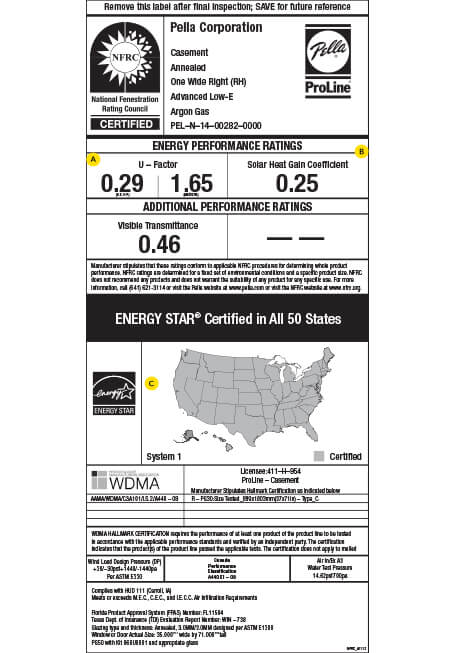Choosing The Best Energy-Efficient Windows For Your Home
Posted
on November 2, 2020

Aesthetics are important but energy efficiency is a crucial consideration when you’re shopping for new windows. By choosing energy-efficient replacement windows, you’ll not only lower your heating and cooling bills; you’ll get a greater return on your investment.
There are a lot of factors that determine how much improved thermal performance and comfort you’ll see in your home. Figuring out what each means to overall energy efficiency will help you find the replacement windows you need.
Why Energy Efficiency Is Important
Old windows tend to allow air to escape or enter through small cracks, missing or improperly installed sealing or inefficient glass. Your home's heating or cooling system has to compensate by working harder to maintain a comfortable temperature. So you end up with higher energy bills and a larger negative impact on the environment.
Energy-efficient windows help resolve performance problems to reduce these effects. When you choose energy-efficient replacement windows, you get:
- Improved comfort – Reducing air leakage from the outside keeps your home more comfortable by eliminating drafts and decreasing noise pollution.
- Lower energy costs – Inefficient windows are one of the biggest reasons for high energy bills. When you alleviate the strain on your HVAC system, you save money. For typical homes, upgrading to ENERGY STAR® windows saves an average of $101 to $538 a year when replacing single-pane windows.1
- Reduced carbon footprint – Quality craftsmanship, expert installation and innovative glass options help limit the impact your home has on the environment. Upgrading from less efficient single-pane windows can save 1,147 to 3,839 pounds of CO2 a year — the equivalent of 56 to 196 gallons of gasoline.2

What Makes a Window Energy Efficient
The ENERGY STAR window ratings display the savings you’ll see when compared to single-pane windows. But there’s a lot more that goes into making a window energy efficient than just the number of panes.
Energy-efficient windows are important, but what makes a window energy efficient? To keep your home warm in the winter and cool in the summer, windows need to reduce the amount of air that escapes through the frame and glass, control the rays of light entering and exiting your home, and the heat transfer through the window. The material of the window and the type of glass you choose will impact the window’s overall energy efficiency.
1. Energy-Efficient Window Frames
Window frames can be constructed from a variety of materials. And different window materials provide different levels of thermal resistance — the amount of heat that can transfer from the exterior of the window to the interior of your home.
- Wood window frames provide excellent insulation, conducting a low amount of heat or cold into your home.
- Fiberglass frames offer similar insulation as wood.
- Multi-chambered vinyl frames reduce heat loss more than non-multi-chambered vinyl, leading to added energy efficiency.
2. Energy-Saving Glass
The type, thickness and style of glass in your window all contribute to energy efficiency. Allowing certain solar rays to enter or exit your home, as well as reducing the conductivity of your glass, can impact the comfort of your home – and your heating and cooling costs. Four factors contribute to the energy efficiency of window glass:
- Number of window panes – Double-pane glass provides better insulation than single-pane, while triple-pane glass can further improve your energy efficiency.
- Glass coating – Glass tinted with Low-E (low-emissivity) coating can reflect solar heat. In the winter, Low-E glass reflects heat back into the room, keeping it warmer. In the summer, it reflects heat away from your home, keeping it cooler. There are different types of Low-E glass, each designed for the climate where you live.
- Insulating gas – Many windows feature harmless, inert gas between the panes of glass, which provides an extra layer of insulation. This gas has a higher resistance to heat flow than air, improving the thermal performance of windows.
- Solar window film – In addition to Low-E coating, there’s solar window film to add more tint to your windows. It works the same way as tint on a car window and comes in a variety of colors. Talk with a window expert to determine if it’s a good option for your home and region.
3. Professional Window Installation
The construction and parts of a window aren’t all that matters. Proper installation is also important. Even the most energy-efficient window can lose its performance if it’s installed incorrectly or doesn’t fit right. Professional window installation helps ensure that your energy-saving window performs the way you expect.
During the installation process, you may have another chance to increase energy efficiency. Insulating foam can be added within the frame of some window materials to provide another layer of protection against air leakage. It’s just one of many small changes that can lead to big boosts in energy efficiency in your home.
What to Look for When Choosing Energy-Efficient Replacement Windows
Energy efficiency is the goal, but it takes on different meanings depending on your climate. So energy-efficient replacement windows are designed to do different things in different parts of the country.
In colder climates, windows that let in more energy from the sun may be best. For hot, sunny climates, you want to block out the sun’s rays and heat as much as possible. And if you live in a temperate climate with hot summers and cold winters, you need windows that balance heating and cooling.
You can find all that information right on the window label. Look for the two main energy certifications used in window energy ratings: ENERGY STAR and National Fenestration Rating Council (NFRC).
ENERGY STAR Replacement Windows
ENERGY STAR is a government program that certifies energy-efficient windows, doors, appliances and other home products. The ENERGY STAR ratings provide guidance on how much energy and money each product will save you.
An ENERGY STAR label tells you whether a window is certified by the program, and in what part of the country. The energy certification could apply to all 50 states or just certain regions. It may also tell you which energy performance ratings to look for in your climate.

Northeastern Climate Challenges and Energy Efficiency
ENERGY STAR also analyzes their certified products and hands out awards every year for the best energy-efficient products on the market. In 2020, several Pella® Lifestyle Series windows received this honor, being designated as one of the Most Efficient ENERGY STAR certified products.4
NFRC Window Ratings
While ENERGY STAR certification gives you confidence that a window is up to energy efficiency standards, NFRC ratings provide deeper details into performance so that you can actually compare the energy performance of different windows.
NFRC is a nonprofit organization that developed an energy rating program just for energy-efficient windows and doors. NFRC window ratings are a reliable way to determine a window’s “whole unit” energy performance — not just the performance of the glass itself. Window manufacturers rate and certify their products with these requirements so that they can earn the status of NFRC window and use the label.

How to Get the Most Energy-Efficient Window Performance
From aesthetics and features to energy-efficient options and installation, buying windows is full of big decisions. You can shop and compare energy-efficient replacement windows, but every feature you add — glass combinations, materials, tinting and more — can change the rating. And none of it matters unless your windows are installed following manufacturer-recommended installation processes to maximize energy efficiency.
Talk to your local window professional to get a little help with your energy efficiency upgrades. A Pella expert can assess your home (for free!) and walk you through all of your options so that you can choose the best energy-efficient windows for your home, climate and budget.
1Source: http://www.energystar.gov/index.cfm?c=windows_doors.pr_benefits
2Source: https://www.energystar.gov/products/building_products/residential_windows_doors_and_skylights/benefits
3For specific information on ENERGY STAR requirements, visit energystar.gov.
4Some Pella products may not meet ENERGY STAR guidelines in Canada. For more information, contact your local Pella sales representative or go to energystar.gc.ca.
Schedule a free consultation to find windows and doors for your home.
